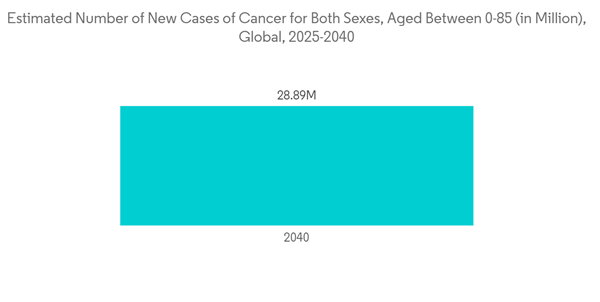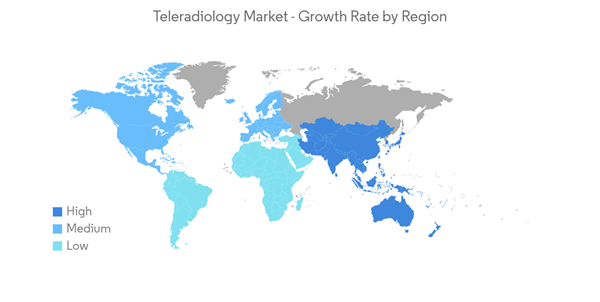The COVID-19 pandemic has continued to transform the growth of various markets, and the immediate impact of the outbreak had varied. While a few industries registered a drop in demand, numerous other markets may continue to remain unscathed and show promising growth opportunities. During the pandemic, teleradiology systems were widely adopted to share study observations and detailed information gathered during the treatment of COVID-19 patients. This has helped prevent exchanging hard copies of imaging results and avoid in-person contact. For instance, as per the article published by NCBI in March 2021, the use of teleradiology to evaluate the effects of lockdown on a particular number of emergency sectors appeared beneficial, and the teleradiology platform can manage numerous emergency departments (ER) across the territory.
Furthermore, initially, due to the lockdown and hold on elective imaging services, there was a decrease in teleradiology services being observed. However, post-pandemic teleradiology has been accepted widely since it bridges the gap in imaging services between rural and non-rural areas. Patients in regions that lack local radiologists can still get diagnostic radiology services through radiologists working remotely through the services provided by teleradiology. Thus, as per the facts mentioned above, COVID-19 significantly impacted the teleradiology market and is expected to do the same during the forecast period.
The major factors responsible for the growth of the teleradiology market include the rising number of imaging procedures, the development of IT infrastructure, the rise in healthcare expenditure, and the increasing prevalence of osteoarthritis and chronic diseases. For instance, as per the article published by the American Cancer Society Journal in January 2022, approximately 1.9 million cancer cases were reported in the United States in 2022. The rising prevalence of chronic conditions, such as cancer, is increasing the diagnostic imaging procedural rate. Hence, the rising number of imaging procedures may boost the demand for reliable and efficient teleradiology solutions, resulting in high growth in the market.
Additionally, the increasing healthcare expenditure is positively influencing the overall market growth. For instance, as per the National Health Expenditure Projections 2023-2024, growth rates in United States health expenditures are projected to be 5% in the current year and 5.1% in the next year. as patient care patterns are assumed to revert to pre-pandemic levels. Teleradiology solutions have demonstrated the ability to enhance health outcomes and reduce costs. Telemedicine has been decreasing the cost of healthcare while increasing efficiency through improved management of chronic diseases, reduced travel times, and fewer and shorter hospital stays.
Moreover, the active participation of prominent players in the launch of various teleradiology platforms is also burgeoning the market growth. For instance, in August 2022, 5C Network launched its artificial intelligence-powered platform Prodigi to interpret radiology images directly from the cloud. This state-of-the-art platform enables teleradiology at a massive scale and makes it possible for diagnostic centers and hospitals to submit scans and access reports. Thus, such developments made by prominent players are projected to burgeon market growth during the forecast period.
Thus, as per the abovementioned factors, the teleradiology market is anticipated to grow over the forecast period. However, the lack of skilled professionals and security concerns associated with teleradiology restrain the market growth.
Teleradiology Market Trends
Software Segment is Expected to Register Fastest Growth Over the Forecast Period
The software segment is an important component of teleradiology, as they are highly used to transmit and analyze these images. Several factors are driving the growth of the software segment in the teleradiology market, including technological advancements, increasing demand for remote healthcare services, growing prevalence of chronic diseases, rising healthcare expenditure, and surging adoption of various cloud-based solutions.The software used in teleradiology is constantly evolving and improving, with new technologies such as artificial intelligence (AI) and machine learning (ML) being incorporated to enhance the accuracy and speed of diagnoses. As these technologies continue to develop, they are expected to drive the growth of the teleradiology software segment. For instance, as per the article published by the Lancet Journal in April 2023, teleradiology software, combined with AI and mobile digital imaging units, can address radiologist shortages and strengthen various programs aimed at population screening and emergency care. Therefore, such studies reflect the significance of AI in teleradiology software, thereby driving segment growth.
Teleradiology can send the images generated from mobile imaging systems in remote areas to doctors in hospitals. Furthermore, most of the software uses technologies like data compression, as most radiologists need to be able to share detailed, high-resolution images. The presence of various prominent players, mergers, acquisitions, product launches, and government initiatives are boosting segment growth. For instance, in November 2022, the radiology tech firm OpenRad launched an enterprise remote reporting platform at the Radiological Society of North America (RSNA). In February 2021, Fujifilm India Pvt. Ltd. launched a mobile digital radiology system - FDR nano.
Hence, due to the factors such as increasing technological advancements and active government initiatives, the software segment is likely to grow significantly over the forecast period.
North America is Expected to Hold Significant Share over the Forecast Period
The geographical analysis of the Teleradiology market shows that North America holds a significant share of the global market, owing to factors such as the rising prevalence of chronic diseases, well-developed healthcare infrastructure, and various strategies adopted by prominent regional players. For instance, as per the data updated by the CDC in December 2022, 6 in 10 adults in the United States currently have a chronic disease. And 4 in 10 adults have two or more chronic diseases. Therefore, such a large proportion of people suffering from various chronic diseases in the region is projected to create a demand for teleradiology devices such as X-rays, CT, ultrasound, MRI, and nuclear imaging, among others.In addition, the increasing investments by government organizations in the region in various health sectors are also projected to increase market growth during the forecast period. For instance, as per the data updated by the National Institutes of Health (NIH), in March 2023, the United States healthcare expenditure in biomedical imaging rose from USD 2,774 million in the past year to USD 3,101 million in the current year. Thus, increasing healthcare expenditure in the country is estimated to drive new developments related to teleradiology in the region, thereby burgeoning market growth. Moreover, the rising number of product launches by the prominent players in the region is also projected to drive market growth during the forecast period. For instance, in March 2023, United Imaging Healthcare launched a whole-body ultra-high field 5.0T MRI.
Thus, given the abovementioned factors, the teleradiology market is expected to grow significantly in North America over the forecast period.
Teleradiology Industry Overview
The market studied is a fragmented market owing to the presence of various market players. The market players are involved in launching new products and expanding their product portfolio to strengthen their market position. Some market players are Agfa-Gevaert Group, Everlight Radiology, GE Healthcare, Koninklijke Philips NV, Onrad Inc., RamSoft Inc., Teleradiology Solutions, and Nanox Imaging LTD (USARAD.COM).Additional Benefits:
- The market estimate (ME) sheet in Excel format
- 3 months of analyst support
This product will be delivered within 2 business days.
Table of Contents
Companies Mentioned (Partial List)
A selection of companies mentioned in this report includes, but is not limited to:
- Agfa-Gevaert Group
- Everlight Radiology
- GE Healthcare
- Koninklijke Philips NV
- Onrad Inc.
- RamSoft Inc.
- Teleradiology Solutions
- Nanox Imaging LTD (USARAD.COM)
- 4ways Healthcare Ltd
- HealthWatch TeleDiagnostics Private Limited
- Carestream Health










